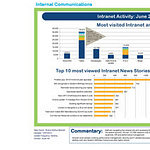This content is part of the Vision for the Public Sector Zone
Introduction
The Engage for Success research by David MacLeod and Nita Clarke 2009 cite creating a clear and compelling narrative as one of the main enablers of staff engagement. The Towers Perrin 2013-14 Change and Communication ROI study demonstrates a clear correlation between effective internal communications and business performance.
The challenge of creating highly engaged and motivated employees is as important to the Civil Service as it is to the Private Sector. To ensure that we continue to deliver excellent public services across the country delivered by a world class Civil Service, takes a workforce that is highly motivated and engaged with each Department’s vision, objectives and proud of what it achieves.
Background
The internal communications challenge in BIS is an exciting one. BIS has 3100 staff spread across the country and is supported by 46 partners. It has three huge responsibilities – business, innovation and skills around which its purpose is to connect people to opportunity and prosperity and create growth in a challenging economic environment.
BIS was formed in 2009 by merging two government departments. This created Communications’ challenges around integrating different cultures, as well as motivating staff through a difficult period of restructure and change.
Our objective at the beginning of 2013 was to increase staff engagement with a more strategic approach to delivering our internal communications, giving staff clarity about the Department’s purpose and sharing the many achievements that were being delivered by teams every day.
Our approach
Staff insights drawn from our People Survey and Internal Communications Audit highlighted setting a clear vision and communicating change in the Department as key areas for improvement. In our Internal Communications audit the message of ‘too much clutter’ in our communications was a universal cry from staff. We also found that while staff could articulate their own team achievements, they struggled to recall specific BIS wide messages.
So we listened to what staff said and stripped back our communications with a brand new strategy and approach.
We streamlined our communications channels to prioritise the most effective and built measurement into every one, so we can see instantly what’s working and what isn’t. We reduced the ‘noise’ by developing a campaign approach to communicating our major change and policy messages reinforcing each campaign through all our internal channels.
The biggest change in our approach was the development of the ‘BIS Story’ – an engaging strategic narrative which enabled us to tell a simple story about BIS’ objectives, purpose and achievements in order to give our stakeholders a clearer perspective about what BIS does and the difference it makes across the country and to build staff pride by celebrating our achievements more openly.
Developing a visionary narrative
It was important to our approach that the BIS Story was created and owned by staff across the Department. We knew it had to be authentic, with themes and language staff could relate to. For BIS, it also had to be a story that embraced the vastly complex remit of the Department in a way that enabled every team member to identify their part in it.
As there had been attempts in the past to create a BIS story that hadn’t been necessarily successful, we wanted to bring objectivity to our renewed approach. Consequently, we invited Undivided, a small creative agency specialising in internal engagement to work with us on building the programme. Undivided worked as an extension of the internal comms team. They brought us some valuable facilitation tools which got our leaders and staff thinking about the Departments challenges, purpose and future in a creative but challenging way.
The BIS story was developed around four phases which ensured that we involved staff and leaders across the Department from the outset and at every stage in crafting the narrative.
i) Explore – we conducted a series of 1-1 interviews with the Executive Board and senior management team exploring their perceptions of the organisation, the challenges and their aspirations for the future of BIS
ii) Write – we ran a number of interactive workshops with a cross section of staff to test with them, the views expressed by the senior team and to start to craft the core themes of the BIS story
iii) Design – we interpreted the themes of the narrative into a visual identity which we could incorporate into our internal communications channels
iv) Activation – we developed a 12 month staff engagement programme in order to socialise the BIS story with staff across the Department. We kicked off with the launch of the final narrative told through video and a supporting visual campaign reinforcing the main story themes around BIS sites. We shared team case studies of achievements and successes uncovered through the story discussions in all our communications channels over several months. The highlight was the BIS Story festival where staff presented their team stories depicting the part they played in the BIS Story to colleagues across the Department.
What we’ve achieved so far…
We evaluated the campaigns success through improvements in our People Survey scores around vision, leadership and communicating change; qualitative feedback from staff focus groups, quantitative monitoring of readership and awareness of the campaign in staff channels.
Ten months into our BIS Story journey and new Internal Comms strategy, the overall engagement score for BIS improved by two points from 2012-2013. We also saw increases of +7% where staff said that leaders gave them a clear vision and 6% increase in staff saying that they felt informed about matters that affect them. Qualitative comments from staff after the BIS Festival said that it filled in the gaps in their knowledge about the wider Department and that the Festival of sharing team stories should be an annual event. The journey to embed the story and increase staff motivation and pride continues with a re-run of the BIS Story Festival in Autumn and the My Story campaign, where team members tell colleagues across the Department of the part they individually play in the BIS Story. We expect to move our engagement scores around vision, communicating change and employee voice even further over the coming months through this continued engagement activity.
Sharon McKoy-Beckett
Deputy Director, Head of Internal Communications
Department for Business, Innovation & Skills




